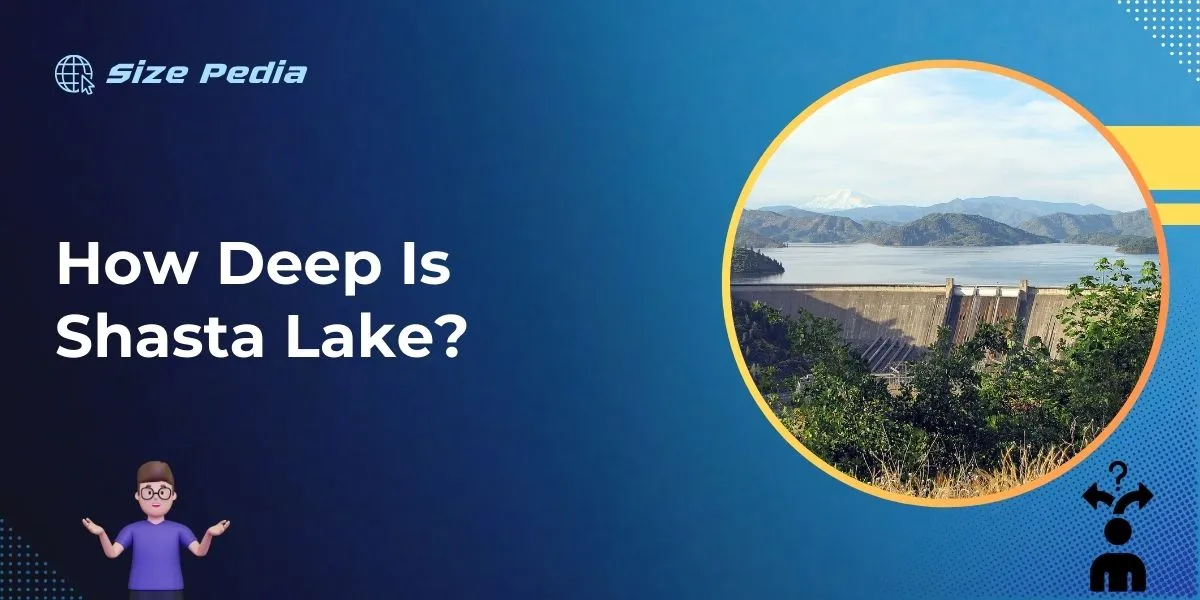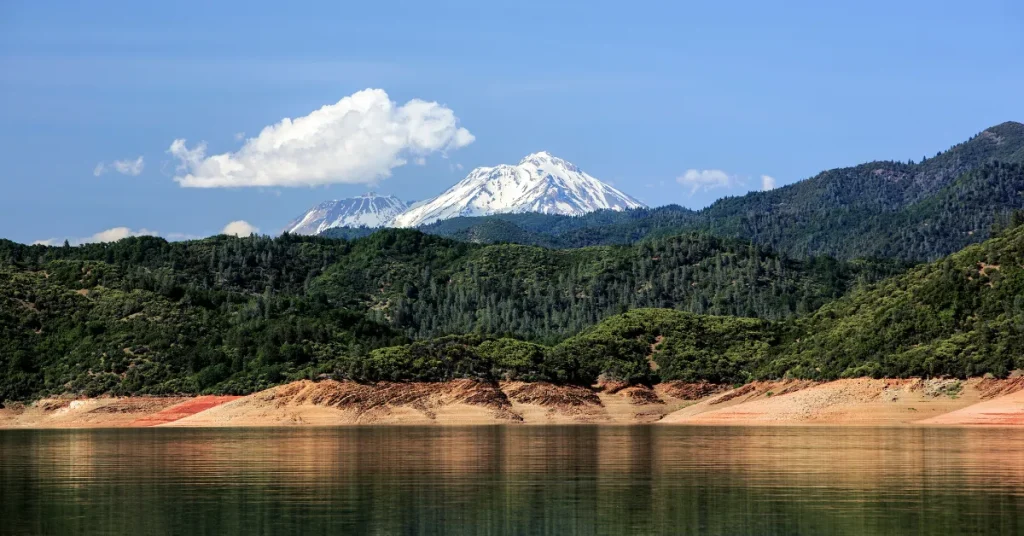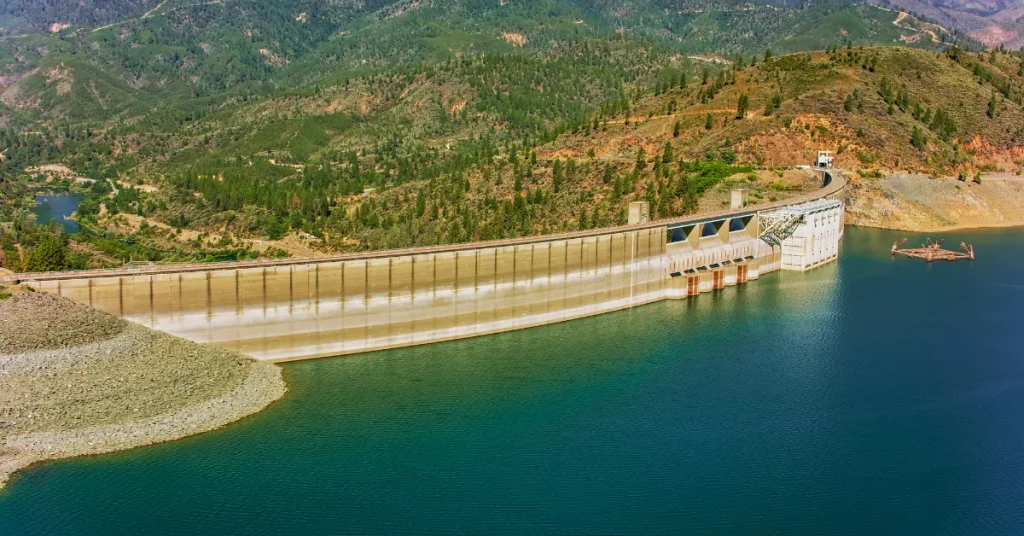Shasta Lake has a maximum depth of about 517 feet at full pool. Its depth fluctuates with seasonal water levels.
Nestled in Northern California, Shasta Lake is the state’s largest reservoir and a jewel of the Shasta-Trinity National Forest. This impressive lake offers a blend of adventure and serenity with opportunities for boating, fishing, and camping along its shores.
Surrounded by rugged terrain and forested mountains, visitors are treated to stunning landscapes and a plethora of activities both on and off the water.
Whether you’re seeking a tranquil sunset over the water or an adrenaline-infused water-skiing session, Shasta Lake provides the perfect backdrop.
Its deep blue waters and expansive surface area make it a haven for outdoor enthusiasts and a must-visit destination for anyone touring the region.

Shasta Lake: A Natural Wonder
Nestled within the Cascade Range, Shasta Lake emerges as a breathtaking expanse of water. As California’s largest reservoir, this natural wonder entices visitors with its scenic vistas and profound depths.
People from around the world flock to experience the beauty and grandeur of this man-made marvel. With an ability to hold about 4,552,000 acre-feet of water, Shasta Lake promises adventure, serenity, and a deep connection with nature.
Geographical Setting
Surrounded by majestic mountain landscapes, Shasta Lake’s geographical position is noteworthy. Situated in Northern California, it acts as the centerpiece of the Shasta-Trinity National Forest.
The topography here is diverse, featuring rugged hills, lush greenery, and volcanic legacy. With inlets and arms stretching like fingers across the land, this lake offers abundant recreational areas for visitors to explore.
Historical Significance
Shasta Lake encapsulates a significant chapter in American history. Constructed during the 1930s and 1940s, Shasta Dam was a feat of engineering part of the Central Valley Project.
This project was vital for providing water and hydroelectric power to California during a period of substantial growth. Today, the lake not only commemorates historical achievements but also serves as a critical hub for water resources, wildlife habitat, and recreation.
Shasta Lake’s depths vary with precipitation and water management practices. At its fullest, the lake can reach depths of up to 517 feet.
The average depth resides around 400 feet, making it a splendid site for water-related activities. Below, find key information about Shasta Lake in table format:
| Feature | Details |
| Location | Northern California, USA |
| Max Depth | Approx. 517 feet |
| Average Depth | Approx. 400 feet |
| Capacity | 4,552,000 acre-feet |
| Constructed | 1930s – 1940s |
The allure of Shasta Lake continues to charm those who seek out its crystal-clear waters and the stories it holds beneath the surface. Visitors revel in the opportunity to experience this natural wonder, its history, and its gifts to the present-day landscape.
Measuring The Depths
Delving into the deep, Shasta Lake’s mysteries lie beneath the surface, and measuring its depths sparks much fascination.
The lake’s fluctuating levels offer a captivating study in California’s water system. Understanding its true depth requires precision and modern science.
Techniques And Technologies
Accurate measurement of Shasta Lake’s depth involves advanced techniques and technologies:
- Echo sounding devices bounce sound waves off the lake bed to measure distance.
- Sonar technology maps the lake floor in detail to provide accurate contours.
- GPS systems determine the exact positioning for depth readings around the lake.
Data from these methods feeds into computer models. The models create a complete picture of Shasta Lake’s depths.
Recent Measurements
Shasta Lake’s depth can vary. It depends on rainfall and water usage. Here are the latest findings:
| Location | Maximum Depth (ft) | Date of Measurement |
| Dam Site | 517 | 2023 |
| Main Body | 400 | 2023 |
| Pit River Arm | 350 | 2023 |
These depths reflect the constant change in Shasta Lake’s water level and highlight the need for ongoing monitoring.
Fluctuating Water Levels

Imagine a bath that never stays full, always rising and sinking. That’s Shasta Lake. Its size changes with the seasons and weather. Understanding these changes helps us plan trips and protect nature.
Seasonal Changes
Shasta Lake’s depth varies as seasons shift. Here’s a glimpse of what happens:
- Winter: The lake fills up as rain and snow pour down.
- Spring: Melting snow keeps the water high.
- Summer: Heat makes water evaporate, and the lake shrinks.
- Fall: The water is at its lowest, waiting for winter rains.
Impact Of Droughts And Rains
Weather extremes transform Shasta Lake. Here’s what happens:
| Condition | Impact on Shasta Lake |
| Droughts | Water levels drop, sometimes revealing old structures. |
| Heavy Rains | Levels surge quickly, which can be dangerous for nearby areas. |
Drought reduces water for homes and fish. Rains restore it. But sudden heavy rain can cause flooding.
The Lake’s Ecosystem
Shasta Lake, a jewel nestled in northern California, is not only admired for its size but its thriving ecosystem. This reservoir’s depth varies, influenced by seasonal rain and snowmelt which can significantly affect the aquatic environment.
Aquatic Life
Shasta Lake supports a diverse range of species. Below the surface, a variety of fish call this lake home, from the native Rainbow Trout to the predatory Largemouth Bass.
- Rainbow Trout
- Largemouth Bass
- Smallmouth Bass
- Catfish
Fishing enthusiasts flock here, eager to cast their lines into the fruitful waters. In addition to fish, the lake houses aquatic plants and algae vital for a healthy ecosystem. These species balance the lake’s nutrients and offer shelter and food for aquatic creatures.
Conservation Efforts
Conservation initiatives are crucial to maintaining Shasta Lake’s ecosystem. Programs in place focus on water quality, habitat conservation, and species protection.
| Conservation Program | Goal |
| Shasta Lake Water Resources Investigation | Ensure sustainable water use |
| Habitat Enhancement Project | Improve conditions for aquatic life |
| Endangered Species Recovery Plan | Protect at-risk species |
Through these measures, the area continues to support an intricate web of life while offering recreational opportunities. Residents and visitors alike benefit from this natural haven, balancing use with a commitment to preservation.
Recreational Activities At Shasta Lake
Shasta Lake sparkles in Northern California as a playground for water enthusiasts.
With its vast waters and picturesque surroundings, this lake invites visitors to immerse themselves in a variety of activities.
Boating And Fishing
Shasta Lake is a paradise for boaters and anglers alike. With wide stretches of water, marinas, and launch ramps, the lake is perfect for:
- Ski boats, pontoons, and fishing boats are available for rent.
- Cruise around idyllic coves or head out for adventurous wakeboarding.
- Fishing enthusiasts rejoice with abundant bass, trout, and salmon promising a great catch.
Fishing spots and boat rentals are easy to find, ensuring an unforgettable Shasta Lake experience.
Scuba Diving: Exploring The Depths
Dive into Shasta Lake’s hidden world with scuba diving. It’s a chance to:
- Witness underwater landscapes few have seen.
- Explore the lake’s depth with guides or join dive groups.
- Discover fascinating remnants from before the lake’s creation, like the Shasta Dam construction site.
Dive shops around the lake offer equipment and courses for beginners and experts.
Challenges In Depth Assessment

Assessing the depth of Shasta Lake poses unique challenges. This magnificent body of water, nestled in California, varies in depth.
Determining its exact depth requires constant attention due to natural and human-induced changes. Let’s delve into the complexities of maintaining precise depth assessments of Shasta Lake.
Sedimentation And Debris
Sediment accumulation significantly alters Shasta Lake’s depth. Sedimentation occurs as materials from the surrounding land wash into the lake.
This process, coupled with plant decay and debris, contributes to gradual depth reduction. Here are some critical points concerning sediment and debris:
- Seasonal runoff brings soil and organic matter into the lake.
- Forest fires in nearby areas can increase the rate of sedimentation.
- Human activities around the lake accelerates debris accumulation.
Maintaining Accurate Depth Maps
The constant flux in Shasta Lake’s depth necessitates regular updates to navigational charts. Ensuring boaters’ safety is paramount. Here are the steps involved in maintaining accurate depth maps:
- Conducting regular sonar surveys to map the lakebed.
- Updating maps to reflect current conditions.
- Providing easy access to updated maps for lake visitors.
With the commitment of local authorities and modern technology, Shasta Lake’s navigational guides remain reliable despite the challenges in depth assessment.
FAQs About How Deep Is Shasta Lake
What Is The Maximum Depth Of Shasta Lake?
Shasta Lake’s maximum depth reaches approximately 517 feet at its deepest point. This measurement may fluctuate with seasonal changes and drought conditions.
How Does Shasta Lake’s Depth Affect Boating?
The depth of Shasta Lake provides ample space for boating activities. However, boaters should stay updated on water levels to avoid shallow areas and ensure safe navigation.
Can You Fish In Deep Parts Of Shasta Lake?
Yes, fishing is possible in deep parts of Shasta Lake. Deep-water fishing can yield various species, including trout and salmon, especially near the dam and deeper channels.
Does Shasta Lake Depth Vary Annually?
Shasta Lake’s depth does vary annually, influenced by snowmelt and rainfall. Lower water levels are typical towards the end of summer and early fall.
Conclusion
Exploring the depths of Shasta Lake reveals not just its waters but its history and allure. This reservoir’s depth varies, influenced by the seasons and rainfall.
Boaters, fishermen, and nature enthusiasts alike treasure it for its versatile landscape and aquatic adventures.
Remember, Shasta Lake’s depth may shift, but its beauty remains constant, inviting visitors to discover its hidden depths year after year.
Resources:
1. https://www.nps.gov/articles/california-shasta-dam.htm
